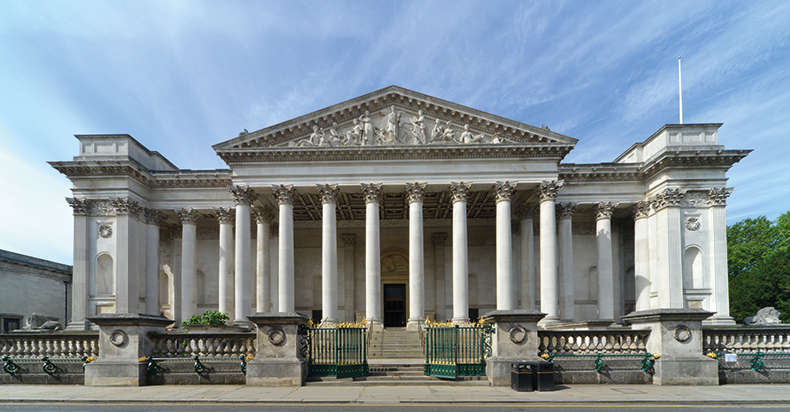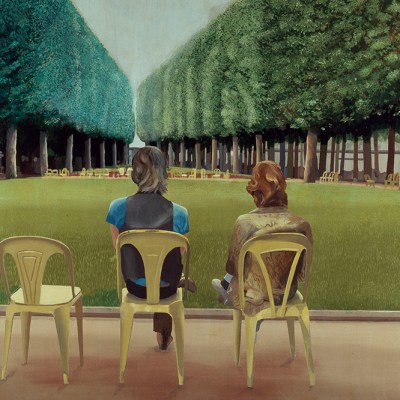From the December 2022 issue of Apollo. Preview and subscribe here.
Coins are not where it normally begins for many museum directors, yet they loom large for Luke Syson, director of the Fitzwilliam Museum in Cambridge. The Fitzwilliam, or ‘Fitz’ as it is affectionately known, is unusual in the landscape of British museums. It has a collection of more than half a million objects, which range from Bronze Age pottery to masterpieces by Titian, to say nothing of its ceramics and other decorative arts (including its coins and medals). It is also, of course, a university museum, occupying a hybrid role – not quite on the level of the national museums but with a bigger public platform than many academic institutions. Among university museums, the Fitzwilliam is rare for the importance and quality of its collection.
However, coins of a different sort are the focus as Syson and I speak, only a few days after the announcement from Arts Council England that the University of Cambridge Museums will have their funding slashed by 50 per cent.
The Fitzwilliam Museum in Cambridge. © Fitzwilliam Museum, University of Cambridge

Syson began his career as curator of medals at the British Museum, prior to which he completed a PhD on the 15th-century royal portraiture of Milan, Ferrara, and Mantua at the Courtauld. While researching his doctorate in the Reading Room of the British Museum, he realised he was sitting next to Ronald Lightbown. Lightbown was, at the time, the Keeper of Metalwork at the V&A but was perhaps best known for his monographs on Botticelli and Mantegna. Syson, in an act that he describes as something he never usually does – because ‘I was shy’ – went up to him and asked him about Mantegna. Lightbown responded with generosity and suggested they have a cup of tea. Syson ventured his theories about Mantegna and, according to Syson, Lightbown said, ‘No, no, no, completely wrong.’ He went on, however, to suggest that Syson look at the portraiture of commemorative medals, ‘if you’re going to think about portraiture in this way’. This advice turned out to be important not only for the PhD – it opened Syson’s eyes to the fact ‘that [looking at] finely connected threads between media across a particular period […] was going to be enormously productive if one was going to ask bigger and more unconventional questions of objects; if you were going to find the stories.’ Finding stories and connections has characterised Syson’s work ever since.
Over the past 20 years, many of the world’s most important museums have sought to design new kinds of gallery displays, with the aim of showing off the connections between objects and the stories these connections tell. Syson has worked on some of the best known of these at various stages of conception and delivery, such as the Enlightenment gallery at the British Museum in 2003 and the Medieval and Renaissance galleries at the V&A. ‘I was involved [in the latter] for just six months,’ he says modestly, though clearly the work he did in planning the galleries with Peta Motture and Malcolm Baker shaped the final appearance of the rooms, which reopened in 2009. Most famously, as chairman of European sculpture and decorative arts at the Metropolitan Museum of Art in New York, Syson oversaw, initially with Ellenor Alcorn, the refurbishment of the Met’s British Galleries. After Syson’s departure for the Fitz in 2019, the galleries were brought to completion by Sarah Lawrence and Wolf Burchard in March 2020.
As such, Syson is better placed than many museum directors to consider the most effective ways of displaying decorative arts. He does not shy away from the central problem that, as he says, ‘the conjunction of painting – and flat art more broadly – with objects is always difficult.’ This is not for any aesthetic reason – rather because ‘they demand a different sort of viewing and they interact with you very differently.’ In Syson’s view, it’s a problem that may well be exacerbated by our contemporary way of living: ‘Something that is on a wall, where the experience is framed, where [the viewer] positions [themselves] in relation to it, is something – especially in an age of screens – we’re all much more familiar with.’ Painters offer us a ‘window on to alternative worlds’, whereas ‘anything else that you’re engaging with [such as objects and sculptures] is part of your world – it’s quite assertive and intrusive.’ To me, it seems unlikely that any of the Fitz’s decorous collection could be seen as bossy – though Syson is quick to assert ‘pink Sèvres, for example’.
Milk jug (Pot à lait à trois pieds), (c. 1770). Fitzwilliam Museum, Cambridge. © Fitzwilliam Museum, University of Cambridge

Few viewers of art shy away from moving nearer to a canvas to appreciate the brushstrokes, but, for Syson, ‘coming up close to a sculpture is a less comfortable experience because a sculpture’s own three-dimensionality demands a longer view.’ Despite the apparently commanding influence of objects upon the viewer, the risk is that when you display flat art and objects together, the audience’s natural comfort with looking at paintings means the objects play second fiddle to the works on the walls.
Syson wanted to confront these problems directly when he was conceiving the British Galleries at the Met. ‘My initial idea,’ he says, ‘was to banish pictures almost entirely. My successors changed that view and introduced more [paintings] than I would have done.’ But then, this is the risk of leaving a project before its conclusion to take on one of Britain’s most coveted museum positions. That said, the Met’s innovative ways of telling the story of Britain and its objects clearly bear Syson’s fingerprints.
At the Fitzwilliam, the question of how to display objects is answered in a slightly different way. It’s about ‘framing them: finding the frame, finding the lighting,’ says Syson – ‘finding the way to seduce the viewer by almost retail methods’. He acknowledges that the displays are a work in progress. ‘I think we do it in some places quite well, in the upper paintings galleries. But to be honest, although some people adore browsing through our ceramics galleries, we don’t give enough clues as to where they might pause. We don’t give enough space, we don’t give enough rhythm.’ Providing ‘points of focus’ is clearly on the agenda.
Installation view of the Fitzwilliam Museum’s current exhibition, ‘Defaced! Money, Conflict, Protest’, featuring examples of early British currency. © Fitzwilliam Museum, University of Cambridge.

Changing how works are approached by visitors is something that the Fitzwilliam is particularly well placed to do. For Syson, part of the richness of a university museum is ‘the wealth of disciplinary approach that we can bring to bear on our collections’, by which he means that curatorial staff are not the only ones shaping the stories being told by the museum. ‘There’s been a sense that that our exhibitions are best and most distinctive when we’re working with academics,’ he says. The current exhibition, ‘Defaced! Money, Conflict, Protest’ (until 8 January 2023) is an example of how to translate an academic thesis into something visually compelling. It was originally slated to be a smaller display, but the flexibility of the Fitzwilliam’s pro- gramme allowed them to make it a full-blown exhibition.
Innovation comes not only from the museum floor but also through wider community engagement. The Fitzwilliam was recently responsible for a partnership with the university that took Egyptian coffins and objects to Wisbech in Cambridgeshire. The small town has a history of chronic unemployment and one of the highest proportions of Brexit voters in the UK. The dilapidated Georgian buildings and the presence of Dickens’s manuscript of Great Expectations in the Wisbech and Fenland Museum are evidence of an illustrious past, but it is not an obvious place to bring such treasures today. ‘What the university museums can do,’ Syson says, ‘is bridge this broad academic community and connect with local, regional, national and international audiences to arrive at different kinds of investigation and different kinds of “impact”, to use a very university word.’
Projects such as this show that the Fitz is not just what Syson calls ‘a grand museum with columns […and] railings that feel less than inviting’. They also make the decision by Arts Council England (ACE) to reduce the funding contribution even more incomprehensible. For the past three years, the University of Cambridge Museums group has received £1.2m. This year, in one of the most reviled funding rounds in the history of the ACE, it was announced that the group would receive just over £600,000. According to the most recent annual report publicly available (2019– 20), ACE contributed 12 per cent of the museum’s income. For an institution of the Fitzwilliam’s size, this reduction in income is crippling. Reading between the lines, there are hints in the same report that ACE was concerned that the Fitzwilliam hadn’t fulfilled its targets of diversifying the audience. Cutting its money won’t help it achieve this.
Syson is clearly in shock when we discuss this. At the time of our interview, he still hadn’t had an explanation. It ‘was announced on Friday [4 November] and we didn’t have any warning that we were going to be cut to that degree. Obviously, we’re extremely disappointed,’ he says. It is a decision that seems particularly odd in light of the fact that the work the outreach and education teams did during lockdown resulted in the Fitzwilliam being ‘consulted by legislators to find out what best practice in this in this area looked like.’
The Italian art gallery at the Fitzwilliam Museum, Cambridge. © Fitzwilliam Museum, University of Cambridge.

Syson has not been shy about the fact that he took on the directorship of the Fitzwilliam to push through what is called the ‘Masterplan’. The scheme was launched in 2016 and was designed to ensure the future of the museum. It has shifted as priorities have changed. Space is one of the big problems for the Fitzwilliam. It needs to find a new home for its conservation work, which is currently carried out at the Hamilton Kerr Institute in the village of Whittlesford. Bringing it closer to the museum is a goal not only for reasons of geography but ‘activity and ambition,’ Syson says. ‘A great store provides access for scholars. Conservation studios in town mean an interaction with scientists.’
All of this comes back to his vision of a university museum that can share knowledge in exciting ways. He doesn’t want to build a vainglorious new building; instead, the aim is to repurpose empty buildings in the city where the Fitzwilliam already operates. It’s a modest approach to a big idea – one he hopes to achieve before he retires in 10 years’ time. Naively, I suggest that since the Masterplan relies on capital funding, it might be able to carry on as planned despite the ACE funding cut. Syson is quick to point out how wrong I am. ‘Nothing is unaffected,’ he says. This ought to have been a conversation about fulfilling bold ideas and bringing new audiences into a museum with one of the most exciting collections and one of the most interesting exhibition programmes in the country; it is shifting ever closer to being a conversation about keeping things going. And that feels unforgivable.
From the December 2022 issue of Apollo. Preview and subscribe here.



